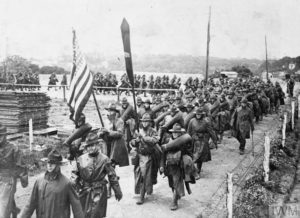Monday August 19th, 1918
Much better again. 98.4. Feeling fine. Good food and attendance. Improving daily.
American Troops
In mid-July, 1918, General Jack recorded in his diary: ‘While awaiting the train a company of Americans passes, big, loose-limbed fellows of a fine stamp….. The enemy must force a victory before the American strength becomes too formidable; otherwise they are certain to lose the War.’ ¹
American Troops Arriving

America declared war on Germany in early April 1917. It had a standing army of only 200,000. By July 1918, the American Army was over 2.4 million with one million of them in France. 10,000 more were arriving every day. The photograph shows American troops arriving at Le Havre on July 12th, 1918.^
At its peak in November 1918 there were almost 3.7 million in the Army and two million of them in France. In total over four million served in the US Army and 4.8 million across all the services.
In fear of the draft almost seventy years earlier, the North during the Civil War, had used a bounty system that proved expensive and cumbersome. Therefore WWI was the first time that the US had used universal conscription and the authorities were surprised how well it was received. The Selective Service Law was passed in May 1917 targeting 18 to 31 year old men, 18% of the male population of America registered in the first year and a further 3% in the second. The criteria were expanded in September 1918 to 18 to 45 year old men and a further 25% registered. In total 24 million men registered and 2.8 million were inducted into military service. The balance was made up of volunteers to the regular Army and the National Guard.²
American Troops Fitness to Serve
Fitness to serve was a significant issue for the British, especially as the war progressed. While less of a problem for the Americans, there were regional variations. A map of the United States overlaid with the relative fitness for service of its male population shows stark difference across the various States.
‘Further analysis of the records of physical examinations shows that the country boys made better records than those from the cities; …. ; the native-born better record than those of alien birth. These differences are so considerable that 100,000 country boys would furnish for the military service 4,790 more soldiers than would an equal number of city boys… 100,000 native borne would yield 3,500 more soldiers than would a like number of foreign born.’³
Despite this, the range is from 50% to 80% who pass the test in every State. No wonder that General Jack also wrote of the American troops, ‘The race is a gift for the Allies if it holds on. It is Waterloo over again, the Americans taking the place of Blücher’s Prussians’.¹
9th Battalion / Manchester Regiment War Diary – 19h August 1918 – Haudricourt
Training and work as per programme. Lt J Schofield rejoined from leave to UK.
References & Further Reading
¹ ‘General Jack’s Diary – War on the Western Front 1914-1918’ edited by John Terraine, Cassell, 2003, originally published 1964. July 16th, 1918, page 245
² ‘The War With Germany, A Statistical Summary’ by Leonard P Ayres, Colonel, General Staff, Chief of the Statistics Branch of the General Staff, Washington Govt Printing Office, 1919
³ ‘The War With Germany….’ page 21
^ Q 6850, copyright Imperial War Museums


